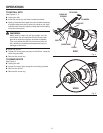
14
OPERATION
WARNING:
Before connecting the drill to a power supply
source, always check to be sure it is not in lock-on
position (depress and release the switch trigger).
Failure to ensure that it is not locked-on could
result in accidental starting of the drill resulting
in possible serious injury. Do not lock the switch
trigger in applications where the drill may need to
be suddenly stopped.
DRILLING
See Figure 10
Depress and release the switch trigger to be sure the drill
is in the OFF position before connecting it to a power
supply.
Check the direction of rotation selector for the correct
setting (forward or reverse).�
Secure the material to be drilled in a vise or with clamps
to keep it from turning as the drill bit rotates.�
Plug the drill into power supply. Hold the drill firmly and
place the bit at the point to be drilled.�
Depress the switch trigger to start the drill.
Move the drill bit into the workpiece, applying only enough
pressure to keep the bit cutting. Do not force the drill or
apply side pressure to elongate a hole. Let the tool do
the work.
WARNING:
Be prepared for binding at bit breakthrough. When
these situations occur, the drill has a tendency to
grab and kick in the opposite direction and could
cause loss of control when breaking through
material. If not prepared, this loss of control can
result in possible serious injury.
When drilling hard, smooth surfaces, use a center punch
to mark the desired hole location. This will prevent the
drill bit from slipping off-center as the hole is started.
When drilling metals, use a light oil on the drill bit to keep
it from overheating. The oil will prolong the life of the bit
and increase the drilling action.
If the bit jams in the workpiece or if the drill stalls, stop
the tool immediately. Remove the bit from the workpiece
and determine the reason for jamming.
Fig. 10
WOOD DRILLING�
For maximum performance, use high speed steel bits for
wood drilling.�
Select normal drilling mode.�
Begin drilling at a very low speed to prevent the bit from
slipping off the starting point. Increase the speed as the
drill bit bites into the material.�
When drilling through holes, place a block of wood behind
the workpiece to prevent ragged or splintered edges on
the back side of the hole.�


















